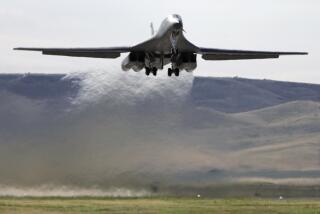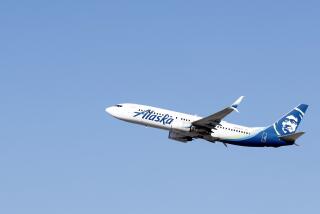Safety Panel Probes Cause of Continental DC-9 Tragedy : Testimony Conflicts on Ice Buildup in Jet Crash
DENVER — Testimony conflicted Tuesday as to whether ice built up on a Continental Airlines jetliner during the long wait between de-icing on the ground and the plane’s unsuccessful attempt to take off during a snowstorm.
Air Force crew chief Gregory S. Wadsworth--a passenger on the DC-9 that crashed here Nov. 15, killing 28 of the 82 aboard--said he saw ice on one engine and patches of ice 2 to 3 feet across on a wing as the plane waited to take off from Denver’s Stapleton Airport.
“It made me real nervous,” Wadsworth told a panel from the National Transportation Safety Board, which opened hearings here Tuesday. “But I figured, ‘They do it every day. Hopefully, they’ll do it this time.’ Unfortunately, that’s not what happened.”
Disagreed With Testimony
However, the pilot of another Continental jetliner, Capt. Wes G. Zimmerman, disagreed with Wadsworth.
“I did not see any dangerous accumulation of snow or ice” on either aircraft, said Zimmerman, who told the panel he was parked about 40 to 50 feet from the DC-9 as the two planes waited to take off.
The NTSB says it is still too early to determine what caused the crash, but attention has continued to focus on three possible factors:
--The possibility that ice accumulating on the plane as it waited in sub-freezing temperatures for takeoff could have added extra weight to the aircraft and altered the shape of the wings so they did not provide as much lift as usual.
--A pair of compression stalls of the engines, possibly caused by the ingestion of ice from the wings or slush from the runway, that could have sapped the plane of power during the critical moments at takeoff.
--The relative inexperience of the pilot and co-pilot.
Zimmerman and Wadsworth were among seven witnesses who gave often-dramatic testimony about the terrible last moments of Flight 1713 and the heroic efforts of the survivors.
Flight attendant Kelly Englehart said that before the plane left the gate, she was so concerned that a new first officer, Lee Bruecher, 26, would be co-pilot that she queried the pilot, Frank Zvonek, 43, to make sure Zvonek would be at the controls when the plane landed on the return flight from Boise.
However, it was Bruecher, who had only 36 hours of flight time in a DC-9, who was at the controls during the ill-fated takeoff attempt from Stapleton. Zvonek, seated beside him, had only 33 hours as a DC-9 captain.
Citing the crash, the Federal Aviation Administration called on airlines last January to avoid pairing relatively inexperienced crew members in the cockpit.
In part because of a mix-up between the cockpit crew and the control tower, the plane sat in sub-freezing temperatures for 25 minutes before takeoff after being sprayed with an alcohol de-icing solution. That is five minutes longer than the unofficial 20-minute limit pilots often impose for such waits.
Wadsworth said he could “see stuff coming up from the runway, it looked like slush,” as the DC-9 accelerated for takeoff.
The airman, who has served as a crew chief in the Air Force, said he “couldn’t really tell” whether the slush flew high enough to be ingested into the plane’s two engines, which are mounted on the fuselage at the back of the aircraft.
However, as the big plane lifted off of Runway 35 Left, Wadsworth said, he heard the popping sounds of an engine compression stall.
Robert Benzon, the investigator in charge of the NTSB inquiry, testified that “several” such stalls occurred in the moments after liftoff. He said the stalls occurred after the cockpit crew lost control of the plane and probably resulted from a “disrupted air flow into the engine intake or the ingestion of debris.”
Survivors said the plane slid from side to side before crashing into the ground, breaking up and overturning on impact.
“I saw a fireball coming from the forward cabin,” Wadsworth told the panel. “It looked like it was coming straight for me, and then it stopped.”
“When I saw the fireball I shut my eyes,” Englehart said. “I thought it was over. I was just waiting for it to get us.”
“I thought, ‘I’m going to die,’ ” Dr. Frederick Helpenstell, an orthopedic surgeon from Nampa, Ida., told the board of inquiry.
“Then I decided, ‘My God, I’ve survived an air crash . . . .’ Then I was sure I was going to burn.”
But the wreckage did not catch fire, and Wadsworth, Englehart and others able to free themselves were soon attempting to rescue others.
“A little 6-week-old baby was crying . . . and everybody was glad to hear that, because we knew that meant she was OK,” Englehart recalled.
“We got the couple with the baby out first . . . and then the others,” she said. “We kind of got in a huddle and put our arms around each other. We hugged each other because we couldn’t believe we were alive . . . . Everybody had thought they were going to die . . . .”
The flight attendant said she returned to the wreckage to find an elderly man, lying on his back, “half in and half out of the plane. . . .”
She said she took her jacket off and put it over him to protect him from the 28-degree cold and rubbed his hands to comfort him.
“I told him, ‘We’re alive and we’re going to be OK,’ ” she said. “He smiled. . . .”
Helpenstell was another of those trapped in the wreckage--in his case, for several hours in an upside-down semi-fetal position, with one arm pinned up over his head.
“There were several of us there,” he said. “We talked very little. There was really no panic. There were some cries of pain, though. And some prayers, I think.”
More to Read
Sign up for Essential California
The most important California stories and recommendations in your inbox every morning.
You may occasionally receive promotional content from the Los Angeles Times.










